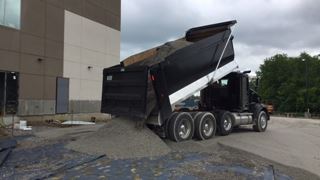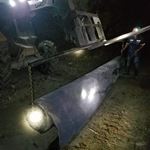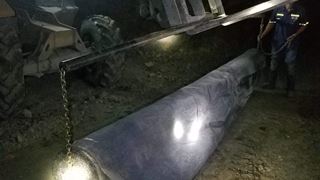Case story
Pond Capping, Midwest, U.S.A
United States
Case Study Form
|
Application |
Pond Capping |
Job owner |
Can Not Disclose |
|
Location |
Midwest, United States |
Engineer |
Can Not Disclose |
|
Product |
Mirafi® CR 440 |
Contractor |
J.B. Holland |
|
Quantity |
15,000 sy |
Date of Installation (m/y) |
August 2015 |
THE CHALLENGE
A large United States electric utility initiated the closure of a CCR surface impoundment in 2015. Engineering plans and specifications were created for the project and was subsequently bid by three general contractors. The impoundment was approximately 8.1 hectare (20 acre) in size with a depth of ash estimated at 9.1 m (30 ft). Project grading plans indicated a balanced site, 50% cut and 50% fill. Fly ash from the cut areas was to be used as fill material. The final cap included 0.46 m (1.5 ft) of compacted clay and 0.15 m (0.5 ft) of vegetated cover.
After reviewing the submitted bids, the utility awarded the project and a notice to proceed was issued. The contractor mobilized and began clearing the existing vegetated cover. The contractor quickly discovered that soft, unsuitable subgrade conditions existed below the firm, dry crust. Fortunately, there were no injuries when this excavator broke through the crust and nearly lost.
Following completion of clearing operations for areas without standing water, the contractor pumped any remaining surface water from the impoundment.
Following completion of these activities, the contractor realized reinforcement of the underlying soils would be necessary in order to complete the project safely and on time. The geosynthetic manufacturer met with the contractor onsite to describe the evolution of geosynthetic reinforcement materials for soft soil applications. A geosynthetic design alternative was prepared, which would allow for the safe placement of both the fill material and compacted clay cap material.
THE DESIGN
TenCate prepared a recommended reinforcement solution to the contractor. Because a thorough soils investigation was not performed, several assumptions were made in the analysis and design stages.
A preliminary stability analysis was performed to assess geosynthetic reinforcement requirements for a cap consisting of a 1.83 m (6 ft) to 4.57 m (15 ft) of fill, 0.46 m (1.5 ft) compacted clay layer and a 0.15 m (0.5 ft) top erosion layer over the CCR material. The fill was modeled on a layer of high strength, high modulus geotextile to provide a construction platform for fill placement and to provide reinforcement for construction equipment traffic loading. The 4.57 m (15 ft) wide geotextile rolls were designed to be sewn together to provide the required level of reinforcement.
The soft CCR subgrade material was modeled in design based on a review of onsite construction videos, photos and moisture test results. A global stability analysis to access performance becomes appropriate when the CCR soils are soft with depth. Additional design protocols include reviewing surface stability concerns utilizing an unpaved design methodology. A unit weight of 1,602 kg/m3 (100 lbs/ft3) and an unconsolidated, undrained shear strength of 9.6 kPa (200 lbs/ft 2) was assumed for the CCR material.
The analysis was completed using the computer program SlopeW by Geo-International. This program uses a two dimensional model. The Spencer method of slices was utilized, which satisfies both force and moment equilibrium. The program searches for critical failure surfaces. A sensitivity analysis was performed, which assumes the consolidated, drained CCR material would have a friction angle ranging from 27 to 37 degrees.
It was recommended that the geotextile be deployed in a sewn panel that is either fabricated on site and then pulled into place or sewn together at the project site. The fill was recommended to be placed and then spread in a direction which tensions the geotextile. If cracks or shifts occur during fill placement, then filling in that area should be stopped to allow the fly ash to settle and for excess pore pressures to dissipate. The analyses showed that pore pressure dissipation must occur in order for a consolidated fly ash friction angle to be achieved.
THE CONSTRUCTION
Following a review of the proposed design recommendation by the contractor and owner, TenCate was authorized to proceed with manufacturing. The contractor decided to have the geosynthetic manufacturer sew panels in the factory rather than hire an installer to field sew the geotextile rolls. Panels were manufactured 22.9 m (75 ft) by 91.4 m (300 ft) and shipped to the jobsite. The contractor unrolled and deployed the panels over the impoundment and fly ash fill was placed directly on the sewn, geotextile panel.
Fly ash fill placement proceeded quickly with no detrimental performance of the underlying subgrade. In cut areas, the geotextile panel was deployed and compacted clay was placed directly on top of the panel. The contractor quickly discovered that mud waves were forming in the CCR subgrade and construction was stopped. TenCate determined that pore water pressures were increasing in the subgrade, reducing shear strengths and causing mud waves. Although the geotextile material has a relatively high water flow rate and permittivity, dissipation of pore water pressure in the subgrade was limited by the relatively impervious clay material placed directly on top of the geotextile. The recommendation was made to add a geocomposite drainage layer directly on top of the geotextile to allow for better pore water dissipation.
Once the geocomposite provided an avenue for dissipation of water coming from the CCR subgrade, the mud waves receded and construction was able to resume.
THE PERFORMANCE
What started as a virtually impossible surface impoundment closure due to soft, saturated subgrade conditions ultimately became a relatively simple and on time construction project. This project was completed ahead of schedule and under budget. The use of high strength, sewn geotextile panels proved to be a cost effective and safe alternative to traditional methods. The owner, engineering consultant and contractor were so satisfied with this closure method that an additional CCR surface impoundment is now being closed with a similar geosynthetic reinforcement method.









.jpg?w=40&h=40&action=crop)